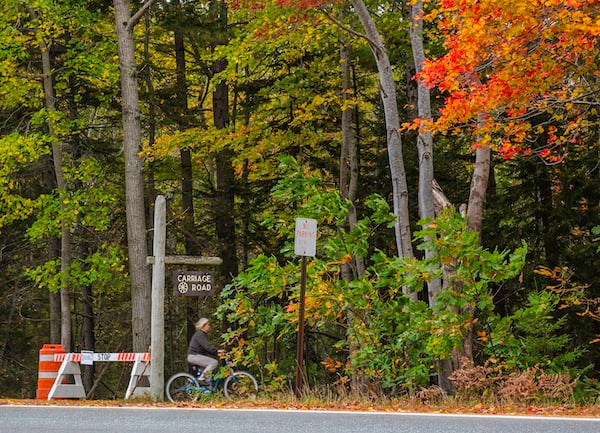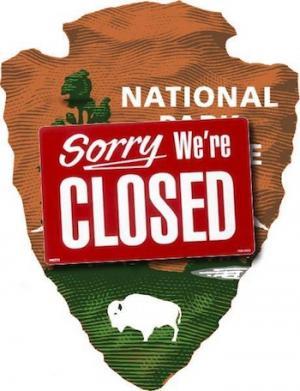Around the country, as the partial government shutdown moves into its second week, taxpayers angry with the closure of national parks are showing their disgust through civil disobedience, mockery, and anger directed at the National Park Service.
The national park idea, long recognized as America's best, is being degraded and disrespected as the result of a much different idea—using the parks as leverage to try to gain the advantage in a political donnybrook.
Many of the government functions impacted by the shutdown, while important, simply don't have the same media interest—or impact on the general public—as closure of the national parks. It's hard to generate a compelling news photo based on the interruption of airliner safety inspection or suspensions of some FDA food safety inspections. Hang a closed sign on the entrance to the Grand Canyon, however, or put a belligerent congressman face-to-face with a ranger at the World War II Memorial on the National Mall, and you have plenty of fodder for the prime-time network news.
The result is an agency and its employees caught in the middle of a fight it didn't create—or want.
Some critics are driven by anger over loss of income from the parks' closure. Others by disgust with Obama administration. Still others seemingly by the belief that the federal government has no right to close the parks. In the end, however, it's the rangers on the ground who are seen as the "face" of the shutdown.
Some Republicans in Congress, particularly in the House, blame the administration for the parks' continued closure, pointing out that that chamber voted to restore funding for the Park Service, among some other agencies and programs. But that legislation was tied to a demand that the Affordable Care Act be scaled back. Some protesting the parks' closure staged an "occupy" movement of Zion National Park last week, a protest that reportedly drew fewer than two dozen.
Many more turned out at Acadia National Park, where they simply walked around barricades to spend a beautiful fall afternoon on the park's Carriage Roads. One of those visitors was involved in a backcountry accident, and the resulting rescue severely taxed the limited resources of a park in "shutdown mode."

At Acadia National Park this week, many cyclists routinely ignored the "closed" signs at the Carriage Roads. Rebecca Latson photo.
No doubt other parks saw visitors ignore the closure signs. There's even a "movement" encouraging people to enter the parks while they're closed.
In Florida, word that the waters of Everglades and Biscayne national parks were being closed led to ridicule of the Obama administration for "closing the ocean." However, the waters adjoining those two parks are as much part of the parks as the Thorofare region of Yellowstone National Park is part of that park, as the Tuloumne Meadows area is of Yosemite National Park, as the Maze is of Canyonlands National Park, and as the Cataloochee Valley is of Great Smoky Mountains National Park.
Too, Biscayne counts approximately 40 keys, or islets, within its watery landscape. That seascape, which comprises 95 percent of the park, also holds historic shipwrecks and fragile coral reefs that have suffered in the past from poachers of history. Those of Everglades hold vital habitat for fisheries.
When those parks were created, the Park Service was charged with overseeing those resources, and with reduced ranks spurred by the failure of Congress to pass a Continuing Resolution to keep the government funded, the agency is sorely lacking the manpower to monitor those areas.
"Whether units of the NPS are historic buildings that can be physically closed by closing a door, or parks with entrance stations able to close with a staff person speaking to visitors or by pulling gates across roads or in the case of some of our nation's most sacred sites, from the Lincoln Memorial to the Jefferson Memorial to the new WW ll Memorial that do not have physical doors or gates to close - these places are all a part of the National Park System whether they have a structure to close or they are sites without a defined entrance point such as the Lincoln Memorial," said Joan Anzelmo, a former park superintendent and now a member of the Coalition of National Park Service Retirees.
"The NPS is responsible for them and they are on federal lands. If left unstaffed in ways the public can see -- and more importantly in the ways the public can't see -- these places will not be preserved the way the agency has been directed to do by Congress," she added. "Congress can't direct the agency on one hand to protect the parks (all of them) so they are unimpaired for the future generations and then suddenly just say never mind- let them be open or let some of them be open. The U.S. National Park System has been an exemplar to the world and parks and the employees should not be played as pawns by Congress."
Regarding the situation at the National Mall, where attention has been focused on access, in particular, to the World War II Veterans Memorial, Ms. Anzelmo pointed to the status of all of the Mall's memorials as icons of our nation ... and also as potential targets for those who wish to do our country harm.
"I worked the shutdown in '95 and '96 and remember there were barricades placed at the Lincoln and Jefferson Memorials in that shutdown. Fast forward these 17 years and the security concerns area thousand times what they were in the innocent 1990s especially at the iconic locations such as the National Mall and Memorials in Washington, D.C.," she said. " There are many behind-the-scenes security-related components, including staff (uniform and plain clothes) that are in place to protect these sacred sites and the millions of people who visit them. When you furlough the vast majority of the workforce due to no appropriation you suddenly reduce the capacity to safely protect the sacred sites themselves and to protect the visitors who wish to visit them. This is very serious business in present day times."
That the National Park System has become a pawn in Congress's malfeasance is unfortunate, regrettable, and unnecessarily places the rangers, and the public, at risk.


 Support Essential Coverage of Essential Places
Support Essential Coverage of Essential Places







Comments
Lee - isn't there some kind of ranch near Tower Junction that isn't open to the general public?
The ranch near Tower is the Lamar Buffalo Ranch. The Yellowstone Association uses it for its field schools. Great facility!
And like the Lamar Ranger Station, the ranch is owned entirely by the park. It is not in any way a "dude ranch."
My guess is that is what the author was referencing. BTW - I too dismissed the story as being hyperbolic.
So what you are saying is that Congress and staffers should be treated differently than everyone else who has health care through their job, including all other federal workers.
Dahkota, let's just hope that American memories remain fresh enough to send ALL incumbent Congresscritters out to seek other jobs next time an election comes around. It's past time for a completely fresh start.
No, I am saying they should not get a plan that is far superior to what is available to the vast majority of the public. They already are treated much differently. They establish their health plan. Employees don't determine what they get from their employers.
"Wyoming Bison vs. Government Shutdown"
http://www.youtube.com/watch?v=nJqmStnPvEw